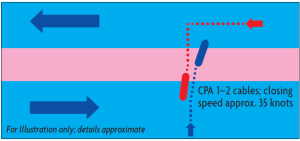The Charity
Aviation
Maritime
Crossing in a TSS

Initial Report
Ships crossing a TSS pass nearly head-on at very close quarters (about 1 cable) at an approximate closing speed of 35 knots. See the reporter’s comments below. The actual location is not revealed in order to preserve anonymity. We do not have an exact track chart, but the reporter’s reconstruction shows the following:

Extracts from the information reported to CHIRP. The reporter commented: [Our ship] ‘was crossing the TSS. Approx midway through the crossing the [other ship] left the far lane’ (shown westbound in the diagram) ‘to cross the near lane’ (shown eastbound in the diagram). ‘The [other ship’] steadied up on a course that led to her and the [reporter’s ship] passing … extremely close. The OOW on the [reporter’s ship] had not plotted the [other ship] and failed to notice that she had altered until it was very late. Instead of taking action he called the [other ship] and use valuable time before the two V/L’s passed less than a cable apart!”.
The Lessons to be learnt
Extreme care is required when crossing a TSS. The red ship has positioned herself close to the separation zone to minimise any crossing risk with the other ships in her own lane, and correctly lines up at 90 degrees to the general direction of traffic flow. We do not have details of other shipping. However the effect of her turn is to place her nearly head on with the reporters. The closing speed is 35 knots. The range closes rapidly. The blue ship’s bridge team only notice the situation at the last minute, and then uses up valuable time on VHF radio with every chance of more, not less, confusion being created; the red ship was also very slow to react. Factors here may include overload on the bridges of both ships causing failure to appreciate the head on situation, and the choice by the red ship of the location for her crossing turn (for example if in the vicinity of a busy ferry route); this choice is at least a major, often the major decision when crossing a TSS.
CHIRP Suggests
Passage planning and thinking ahead. It is wise to plan a crossing manoeuvre where there is no reason to expect a higher than average number of other crossing vessels (for example at a known ferry crossing point). A good method is to identify a ‘crossing window’, marked on the chart in advance, within which the crossing should be conducted. Masters should plan the moments and the circumstances in which they need to be on the bridge well in advance (see CHIRP’s Suggestions, in the precious article). Execution. When preparing to cross a TSS, think well ahead. Assess traffic in the lanes, and choose – if you can – a moment to cross where a gap is likely to open or where you are unlikely to create crossing situations with more than one ship at a time. Throughout use the Mark 1 eyeball, combined with compass assessments of bearing movement if CHIRP Suggests – continued compass azimuth rings are fitted. Use Automatic Radar Plotting Aid (ARPA) trial manoeuvre to help decide the moment of turn, if not clear by other means. Use relative tails to help quickly to confirm new CPAs after the turn. Use Automatic Identification System (AIS) in which other ships’ course alterations change can become apparent almost immediately, and in which track data can assist in the assessment of a ship’s destination and therefore probable intention. Beware bridge overload, especially in heavy shipping and complex situations. Both are almost certain to apply in TSSs. Brief and motivate lookouts, and bring an additional officer to the bridge if in doubt. Be conscious of the speed at which events can unfold. At 35 knots closing speed, two ships close by over 2 nautical miles in 4 minutes. Dangerous situations, increasing the risk of misjudgement or a mistaken understanding of another ship’s intentions, can develop very quickly.
A General Comment on Traffic Separation Schemes
A third report outlined a situation in which, in a busy TSS, a ship in one lane experienced a CPA of 3 cables with a vessel in the other lane. In the absence of the identity of and comment from the other ships, the CHIRP Maritime Advisory Board decided not to make a full report of this incident in the Maritime Feedback. But the circumstances again emphasise the dangers of navigation in busy TSSs.
The key message is: don’t become too ‘comfortable’ in TSSs. High densities of large, deep draught, heavy displacement ships – often at high speed, and often mixed with many other types of craft with differing manoeuvring characteristics – heightens the risk of collision. Things can change and develop fast. If, for example, we don’t notice an unexpected speed or course change almost immediately, collision can become inevitable or nearly inevitable very quickly and at considerable range. A VLCC may take 5 nautical miles to come to a dead stop, require 2 nautical miles each of advance and transfer for a significant turn, take 20 minutes or so to apply astern revolutions from service speed, and become almost entirely unmanoeuvrable once committed to a first major manoeuvre. Never relax vigilance.







